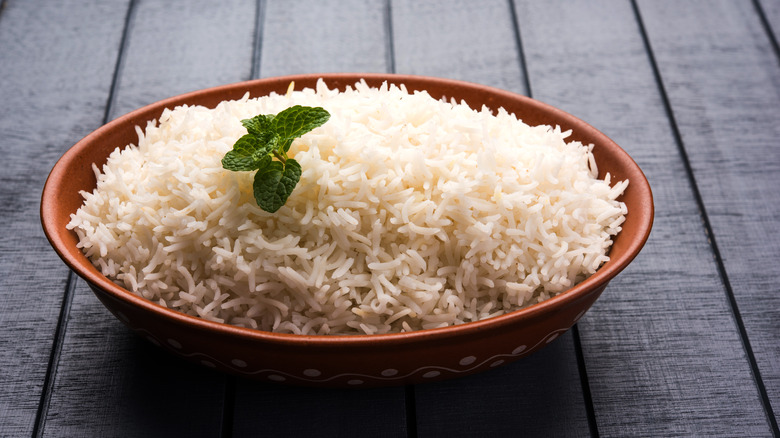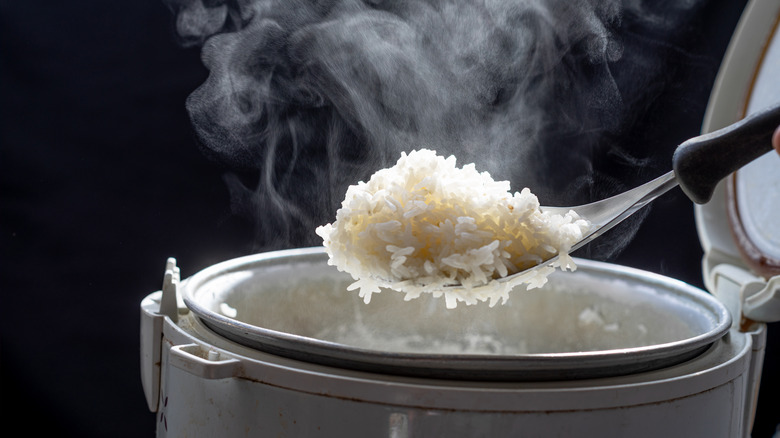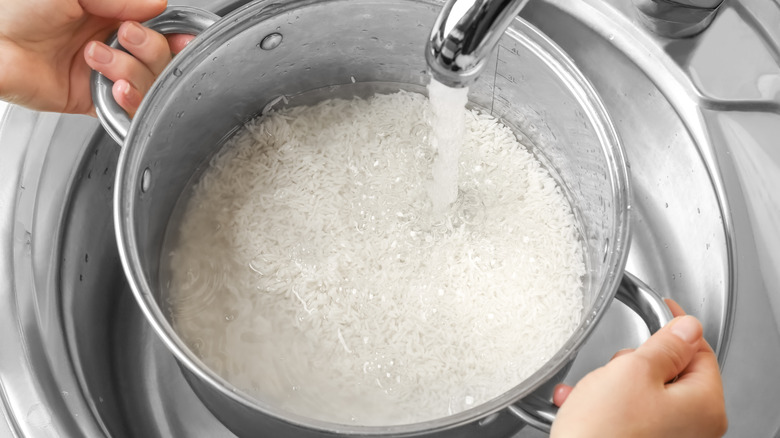The Key Preparation Difference Between Basmati And Jasmine Rice
We may receive a commission on purchases made from links.
Rice is one of the most common grains to add to your plate as it can pair well with almost anything. With its plain makeup, rice is a versatile choice that is perfect to balance alongside dishes like sheet-roasted chicken thighs or a flavorful lemon-rosemary flank steak. But as common as the cereal grain is, its many variations mean it's not always easy to choose the right variety. Per MasterClass, there are upwards of 10,000 kinds of rice.
Two of the most common types of long-grain rice varieties are the popular aromatic choices of jasmine and basmati. While these both share a similar look, texture, and taste, there are slight differences between the two that are important to note. One of the most key things to take note of is how they're each prepared. Most people don't realize there's a whole different method to cooking basmati rice versus jasmine, and it's a change that could make or break the taste and texture.
Basmati v. Jasmine rice: what's the difference?
Jasmine and basmati rice are both white, long-grain varieties of rice. According to Greatist, this means they're both fluffy when cooked and not too sticky like glutinous rice. Per the Web Restaurant Store, the differences between the two cereal grains begin with each type's smell. Basmati rice has a nutty aroma and is most commonly used in Indian cuisine such as in curries. Jasmine rice, on the other hand, comes from Thailand and has a much more buttery, floral-forward aroma. According to Chef Amanda Maneesilasan, more changes start to show themselves after you cook them, via Food Network. When heated, jasmine rice becomes slightly sweet and moist, while basmati rice retains its nutty, floral smells and a firmer texture.
Per America's Test Kitchen, the reasons for those differences in texture come from scientific differences in the two's makeup. Jasmine rice's rich levels of starch contain more amylopectin, which is a molecule that is shaped so that the pieces of rice cling together, while basmati rice contains an excess of amylose, which is much more compact and lets the rice retain its individual shape. Since one of the biggest differences between these two rice varieties is their unique textures and shape, it's important to prep them right so you can properly satisfy your palate.
The key prep difference between these two
While jasmine and basmati rice are both aromatic long-grain rice and share similar qualities, one of the biggest differences between the two is in their preparation. According to MasterClass, good preparation is especially key for basmati rice. To start, you should always still rinse both of these rice varieties to avoid excess stickiness, per Greatist. Doing so is an important step in the process also because it removes excess starches and ensures the rice doesn't clump together. But when you're preparing your basmati rice, it will need some extra time to soak compared to jasmine, says The Washington Post.
Since basmati rice has a harder texture, you should soak it in water for at least 30 minutes before cooking. Per Chef Balakrishnan, soaking your basmati in water also helps to hydrate it before cooking, which helps ensure it is cooked thoroughly and has a good texture, via HuffPost. Since jasmine rice already has a soft feel, it doesn't need extra soaking time. So no matter which type of long-grain rice you prefer, make sure to leave a little extra time to prep according to the variety's makeup.


